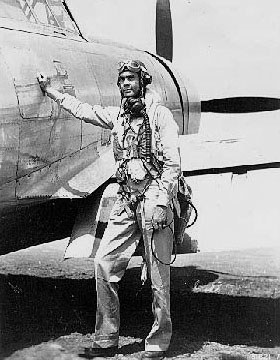
Heroes of WWII: The Tuskegee Airmen
the U.S. Army Air Corps, which would later evolve into the U.S. Air Force.
Trained at the Tuskegee Army Air Field in Alabama, they undertook over 15,000
individual missions across Europe and North Africa during World War II. Their
remarkable achievements garnered them more than 150 Distinguished Flying
Crosses, and their prowess played a pivotal role in advocating for the eventual
integration of the U.S. armed forces.
The Rise of the Tuskegee Airmen
particularly evident in the armed forces and society at large. The nation was
captivated by aviation heroes such as Charles Lindbergh and Amelia Earhart,
prompting numerous young individuals, including African Americans, to aspire to
become pilots. However, deeply rooted racist beliefs propagated the notion that
black individuals were incapable of mastering flight and handling complex
aircraft.
President Franklin D. Roosevelt took steps to expand the civilian pilot
training programme in 1938, a time when racial segregation persisted not only
within the armed forces but also across the nation. Many military factions,
especially in the Southern regions, held prejudiced views of black soldiers,
assuming their inferiority in combat. Advocacy from civil rights groups like
the NAACP, bolstered by influential black newspapers like the Chicago Defender
and Pittsburgh Courier, urged for the inclusion of black Americans in the
military.
The Tuskegee Experiment
1940 when President Roosevelt announced that the Army Air Corps would initiate
training for black pilots. The Tuskegee Army Air Field in Alabama, situated
within the segregated Jim Crow South, was chosen as the training site. A
diverse cohort of, primarily college graduates, enrolled in the Tuskegee programme, encompassing not only pilots but also navigators, mechanics, instructors, and other support staff.
One standout figure was Benjamin O. Davis Jr., who was among the first
aviation cadet class in 1941. His remarkable background as a West Point
graduate and the son of Brig. Gen. Benjamin O. Davis - one of only two black
officers (other than chaplains) in the U.S. military - further
highlighted the significance of this endeavour. The "Tuskegee
Experiment" gained momentum when Eleanor Roosevelt's visit in April 1941
led to increased publicity, thanks to a flight demonstration by Chief Flight
Instructor Charles "Chief" Anderson.

By <a rel="nofollow" class="external text" href="https://www.flickr.com/people/49487266@N07">SDASM Archives</a> - <a rel="nofollow" class="external text" href="https://www.flickr.com/photos/sdasmarchives/6550573797/">Alfonso Harris and Tuskegee Airmen</a>, No restrictions, Link
The Tuskegee Airmen in WWII
Squadron was deployed to North Africa. Operating P-40 planes, they engaged in
missions alongside their white counterparts. Facing initial scepticism about
their performance, the 99th eventually proved their capabilities and, after a
transfer to Italy, formed the 332nd Fighter Group. Operating P-51 Mustangs, the
iconic "Red Tails," they escorted heavy bombers into enemy territory.
Their legacy remains intertwined with their feats during WWII. Their accomplishments, however, were not devoid of challenges, as they contended with racial prejudice even upon returning home. Nevertheless, their contributions played an instrumental role in laying the groundwork for the integration of the U.S. Armed Forces. In 1948, President Harry Truman's Executive Order 9981 officially desegregated the military, establishing equality of opportunity and treatment.

By U.S. Air Force photo - <a rel="nofollow" class="external free" href="http://www.af.mil/shared/media/photodb/photos/070207-F-9999J-026.jpg">http://www.af.mil/shared/media/photodb/photos/070207-F-9999J-026.jpg</a> at <a rel="nofollow" class="external free" href="http://www.af.mil/photos/index.asp?galleryID=3309">http://www.af.mil/photos/index.asp?galleryID=3309</a>, Public Domain, Link
Key facts & figures
Sixty-six Tuskegee Airmen died in combat.
Overall, The Tuskegee Airmen destroyed 251 enemy airplanes and were
More than 10,000 black men and women served as support personnel to
the Tuskegee Airmen, including navigators, bombardiers, mechanics,
instructors, crew chiefs, nurses, and cooks.
There were approximately 15,000 trailblazers who were part of the
historic military flying programme to train black aviators.
Societal Impact of the Tuskegee Airman
Several members, including Benjamin O. Davis Jr., George S. “Spanky” Roberts,
and Daniel “Chappie” James Jr., pursued extended careers in the military,
breaking down barriers and achieving historic milestones. Recognising their
significance, over 300 original Tuskegee Airmen were awarded the Congressional
Gold Medal in 2007 from President George W. Bush. Another testament to their
enduring legacy, surviving members attended the inauguration of President
Barack Obama, who acknowledged their pioneering efforts as instrumental in
shaping his own path of public service.

By White House photo by Eric Draper - <a rel="nofollow" class="external free" href="https://georgewbush-whitehouse.archives.gov/news/releases/2007/03/images/20070329-6_d-0927-515h.html">https://georgewbush-whitehouse.archives.gov/news/releases/2007/03/images/20070329-6_d-0927-515h.html</a>, Public Domain, Link
By <a href="//commons.wikimedia.org/w/index.php?title=User:6oclocklow&action=edit&redlink=1" class="new" title="User:6oclocklow (page does not exist)">6oclocklow</a> - <a rel="nofollow" class="external text" href="http://images.globalair.com/ganimages/generic/Warbirds/North%20American/Mustang/P-51/Exterior/red_tail_p51_OSH_e.jpg">Globalair.com image library</a>, CC BY-SA 3.0, Link
 Skip to content
Skip to content


David Pollock
What a Co incidence I just watched the movie last night, it’s one of my favourites, along with Hidden Figures it highlights the prejudices that the coloureds had to endure.